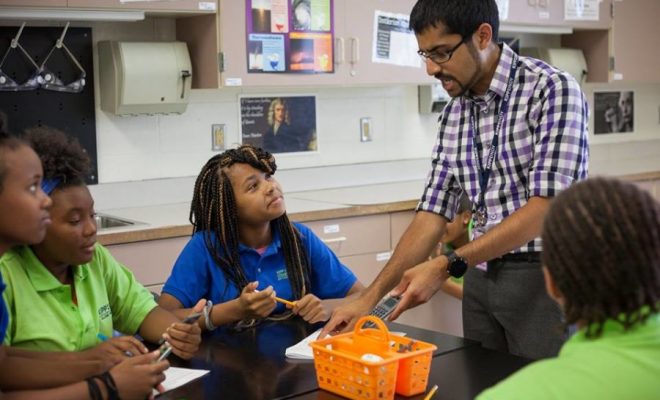Technology lets students ‘flip’ the field trip

North Carolina museum’s “flipped field trip” lets high school students share art creation virtually

Kelsey Hunt, left, and Harley Graham, right, students from Fairmont High School in Fairmont, North Carolina, pose with Joel Shapiro’s ‘Untitled’ as part of a virtual exhibit they created during a “flipped field trip” at the North Carolina Museum of Art. Photo: Ashley Berdeau
Last spring, crowds of teenagers were let loose in Raleigh’s North Carolina Museum of Art. No tour guides, no shushing teachers, just kids following their curiosity through the galleries. As they roamed, they used smartphones and tablets to upload images of the artworks into personalized, virtual exhibits they would later display to their fellow students.
It was a field trip with a tech-y twist: For weeks leading up to the museum visit, these same kids had explored these same works of art on a social-media website, where they also posted sketches, ideas and peer critiques in preparation for their own art projects.
Hoping to spark creativity and give students a real taste of the artistic process, art teachers from 16 high schools across the state had signed up their students for this pilot project, which museum staffers dubbed a “flipped field trip.” Called “Artists in Process,” it was loosely based on the model of the “flipped classroom,” in which teachers assign online reading, Youtube lectures and other digital resources as homework to cover facts, figures, dates and other basic information, then students spend class time in deeper discussions, analysis and collaborative projects.
“Our challenge was to make the museum experience active, engaging and personal for all students,” said Emily Kotecki, the museum’s distance-learning educator. “Art isn’t one size fits all.”
Working with a company called Odigia that designs online learning platforms, the museum created a social-media site stocked with images from its collections, video interviews with artists and discussion questions, all tied to one of three themes — identity, place, and storytelling.
“Having a space online where students could interact with others around the state made them feel like they were part of this larger community,” said Chapel Hill art teacher Jack Watson, whose high school was paired with a school in the mountainous west of the state. “They are learning how artists work and how to use other artists as resources.”
According to Lauren Rieth, an art teacher from rural Davie County whose school was paired with one in the city of Fayetteville, the program gave her students the chance to practice thinking for themselves, beyond meeting the demands of a teacher’s assignment — a degree of freedom that often has her students “shaking in their boots.”
“The hardest part of teaching is that students have to flounder a bit sometimes,” she said. “And you have to let them.”
Despite their reputation for over-sharing, getting high school students to post unpolished ideas and to interact online with kids they didn’t know took time, and prompting.
“They weren’t ready to share and be social until they had grasped onto their own artistic direction,” said Rieth. “But then they just started uploading all sorts of things.”
After a few weeks of virtual brainstorming, it was time for phase two. The paired classes met at the museum. They were put into groups of three or four kids, based on their chosen themes, and left to explore the museum on their own for a few hours. Each group had a smartphone or tablet computer, to take pictures of art that spoke to their theme and to use Pinterest or Instagram to create a virtual exhibit they would present at the end of the day.
“No matter how high-resolution the images are online, there’s no substitute for being face-to-face with a work of art, seeing the brush strokes, and having this connection with something that’s right in front of you,” said Watson. He admitted that some students didn’t think deeply about the art they used in their virtual exhibits, but said others “followed their curiosity through the gallery and found something they didn’t expect, which sparked new connections to their own work.”
For example, while exploring the museum, one girl in his class whose theme was “place” discovered Andrew Wyeth’s painting, “Weatherside,” the subject of which is the side of a sun-bleached farmhouse and barn.
“She was really struck by this painting and how art can take mundane images and experiences and give them weight, gravity and beauty,” said Watson. “She ended up doing a similar painting of the side of her house and a view into her backyard that she only sees in the morning while waiting for the bus. It was a very private and personal space, and she painted it beautifully in the morning sunlight.”
Elizabeth Merritt, founding director of the Center for the Future of Museums, an initiative of the American Alliance of Museums, said lots of museums are using technology to enhance their reach to younger audiences and to expand their role in “learning ecosystems” beyond the traditional classroom.
“You give me just one or two students in a museum, and I’ll give them a unique experience with no technology whatsoever,” said Merritt, who is familiar with the pilot program in North Carolina. “But the use of technology in this case is unique, because it allows them to scale up that personalization.”
After leaving the museum, it was time for phase three, in which students returned to their schools and worked on their final art project, all the while uploading photos of their works in progress to the shared site while seeking and providing critiques.
Three of Rieth’s students successfully placed their art in the museum’s annual “Teens, Inspired” exhibit, which runs all summer. One freshman, Elizabeth Beauchamp, won third place for her art, titled “Wave of Emotion.” In the piece, plaster fingertips and a woman’s face push their way up through a colorful acrylic painting. Beauchamp was inspired by the ancient Greek statue of Nike, the winged goddess of victory, as well as photographs of hands by the North Carolina artist Linda Foard Roberts.
“Going through this artistic process gave depth and richness to their work,” said Rieth. “I’ve been teaching for 14 years. I studied at the Corcoran [Gallery in Washington, DC] and had a master painter teach me these things. But I was never able to put them into teaching until this.”
As proud as Rieth is of Beauchamp’s award, she’s even more pleased by what her student wrote in the artist’s statement that accompanies her work.
“I changed the work at least seven times trying to figure out what I wanted to do with it,” Beauchamp wrote. “I started to play with a lot of media, trying some clay things, then some drawings, and finally I started a plaster painting….. About a week after I plastered, I realized where I wanted to go and I went.”
This story was written by The Hechinger Report, a nonprofit, independent news organization focused on inequality and innovation in education. Read more about Blended Learning.
Chris Berdik is a science journalist who has written about a wide variety of topics, including the intersection of science with ethical issues and the peculiarities of the human brain.






